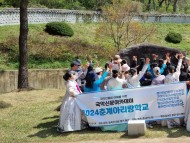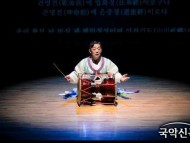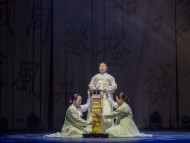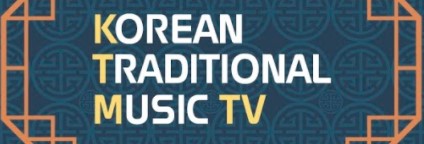2024.04.20 (토)
논문초록
본 논문은 경기민요 명창 묵계월의 생애사Life history를 통해, 경기민요의 근․현대사를 정리함으로써, 전통예술의 학론적 기반을 구축하고자 함에 그 목적이 있다.
‘명창의 생애사’란 명제의 특성상 가계家系는 물론, 특히 ‘구술심전口述心傳’에 의한 도제식徒弟式 전수傳受 교육상 사승師承 관계를 예의 주시했다.
묵계월의 가계는 당시 대부분의 가창가歌唱家가 그러했듯이 한미寒微해 11세부터 20세까지 양어머니에 의해 교육된 소리꾼으로 출발했지만, 중요무형문화재로 선발된 이후 비로소 예인藝人으로서의 신분 상승, 나아가 그 영예에 충실하고자 자신의 사명감에 솔선수범率先垂範하였음을 증명하였으며, 사승관계를 통해 경기민요에 관심 갖게 된 동기 및 그 학습과정과, 공연 및 음반활동, 특히 경기민요연구회 결성과 연구회 활동, 나아가 경기민요의 무형문화재 등재 과정을 경기민요의 발달사적 차원에서 정리하였다. 물론 이상의 정리 작업이 참고문헌을 통한 연구·정리가 아니라. 온전히 한평생(80여년) 경기민요 가창자로 살아온 묵계월과, 40여년 스승으로 모시고 함께 활동해 온 연구자와의 대담 녹취는 그 어떤 유형의 문헌적 기록 이상의 귀중한 자료적 가치를 지녔으며, 노령으로 인한 기억상실은 몇몇 문헌에서 보충하므로, 묵계월 개인의 전기적 가치 이상 경기민요의 발전사적 가치 및 미래 제시적 연구물이고자 하였다.
특히 목계월·안비취·이은주 3인을 주축으로 한 경기민요연구회의 세 명인은 경기민요 무형문화재로 등재된 이후, 이들 명인은 생활인으로서의 명창이 아닌, 공인, 이른바 예인藝人으로서의 품위는 물론, 사명을 다 했음을 무대공연 및 왕성한 음반활동, 그리고 민속예술의 대중화에 기여한 민속공연활동의 시례를 다양한 팜플렛 및 초대장·홍보게시물 등 자료 제시를 통해 예증했다.
그 중 특히 묵계월의 남다른 업적은 거의 독보적으로 이문원 소리선생으로부터 전수傳受해 완창完唱해 오던 송서율창誦書律唱의 맥을 제자 유창에게 전수傳授해 2009년 서울시 문화재 제 41호 송서율창 보유자에게 계승하므로 스승의 도는 물론, 당대에서 끊어질 뻔했던 한 전통예술의 맥을 이었다는 점에서 참다운 사도師道를 다했다 할 것이다.
이 밖에도 묵계월의 문하에는 인간문화재 보유자 2명, 전수조교 4명, 전수 장학생 5명, 대통령상 수상자 9명, 경기민요 이수자 36명 등 많은 후학을 양성하므로 민속예술가로서는 물론, 위대한 교육자의 역할을 다했을 뿐만 아니라, 예능 못지않게 중시한 인성교육의 면면을 점검하고 예증하였다.
따라서 묵계월 명창 한 분의 생애사 논고였지만, 이 논고를 통해 초기 한국 민요의 발달 과정은 물론, 앞으로 국악인 모두가 사명처럼 수행해야 할 과제를 제시하므로 경기민요의 발전사 및 위대한 교육자로서의 면모를 밝혀 후학의 귀감으로 삼고자 했다.
This article aims to establish an academic basis of Gyeonggi folk song, a type of Korean traditional art by examining the modern and contemporary history of Gyeonggi folk song through the life history of a master singer Muk Gyewol. Following the typical definition of ‘life history’ of a master singer, the article particularly focuses on both the pedigree, and the unique relations between a master and pupils that are formed especially when obeying to masters and his or her teachings are considered as strictly absolute and such teaching are usually orally passed down to the pupils.
As most other singer families did in Korea, Muk’s family had low social status. When she was eleven, Muk started her career as a professional folk song singer under the teachings of her stepmother, which continued till she turned to twenty. It was not until she was selected as an Important Intangible Cultural Heritage when she was finally upwardly mobile. The article shows how Muk took the initiative and set an example of a master singer in order to devote herself to the honor of the Important Intangible Cultural Heritage. Also the article attempts to explain Muk’s reasons and motivations to get involved in Gyeonggi folk song, the learning process, performance and other activities such as forming Gyeonggi folk song research association and its activity by thoroughly understanding the relations between a master and pupils. Moreover, the process of listing Gyeonggi folk song as an Intangible Cultural Property was examined from the aspect of the development of the Gyeonggi folk song.
This research is not just conducted through the examinations on references or previous researches. It also includes the record of conversation between the researcher who has been a pupil of Muk for about 40 years and Muk herself who has lived as a master singer of Gyeonggi folk song for her whole life. Surely it is more valuable resource than any other literature records on this topic. However, Muk’s loss of memory due to old age was supplemented by other literature records. Hence, the article proposes more than just an individual biography: the valuable development of Gyeonggi folk song and its future value. After they were designated as an Intangible Cultural Treasure, Muk Gyewol, An Bi-chwi, and Lee Eun-joo, who are master singers as well as the main figures of the Gyeonggi folk song research association, not only maintained dignity as a public figure but also greatly performed their mission as a master singer. The article also illustrates it through their stage performance, active involvement in recording and shows how folk performance contributed to popularization of folk art by investigating various pamphlets, invitations and advertisements of the performance.
The unique and great achievement of Muk Gyewol is in her making great efforts to teach and passing down her skills to her pupils, which can be seen as unequaled. She had carried on the legacy of singing Songseo-yulchang that she learned from her teacher, Lee Munwon and succeeded to her pupil, Yoo Chang who were designated as the 41 Intangible Cultural Treasure of Seoul in 2009. As a result, it can be said that Muk prevented the tradition from being broken off. Surprisingly, under Muk’s teaching there are two students who hold the designation of Human Cultural Asset, four apprentices as assistant instructors, five apprentices with scholarship, nine awardees of President Prize and thirty six students who completed the Gyeonggi folk song course. She fostered numerous pupils and fulfilled the mission both as a master singer and folk artists. Furthermore, she not only focused on the students’ skills as a singer but also paid close attention to build students’ upright character as an individual
In conclusion, the article deals with the life history of a master singer, Muk Gyewol and covers the overall history of Korea’s Gyeonggi folk song. Also it shows how Muk Gyewol has set an example of a great teacher for the future generation and successfully fulfilled her mission as a master singer through her whole life. Finally it suggests tasks that are assigned to other younger Korean folk singers.
- [] 제32회 전국청소년민속예술경연대회(05/18)
- [] 제42회 전주대사습놀이 학생전국대회(5/18∼6/2)
- [] 제50회 전주대사습놀이 전국대회(5/18~6/3)
- [] 제4회 함양 전국국악경연대회(05/12)
- [] 제18회 대한민국 전통예술무용·연희대제전(06/09)<br>무용(전통무용…
- [] 제48회 부산동래 전국전통예술경연대회(06/15-16)(무용.기악)
- [] 제1회충남전국청소년국악경연대회(05/04)(판소리.기악.타악)
- [] <br>[광주]제21회 대한민국 가야금병창대제전(06/16)
- [] 제18회 과천전국경기소리경창대회(05/04)
- 제11회곡성 통일전국종합예술대전(06/15-16)
- [] 제24회 인천국악대제전 전국국악경연대회(05/25-26)
- [] 제26회 창원야철전국국악대전(07/06- 07)
- [] 2024 무안장애인 승달국악대제전(06/01-02)
- [] 제22회 무안전국승달국악대제전(06/01-02)
- [] 제10회 전국공주아리랑민요경창대회(05/26)
- [] 제17회 상주전국국악경연대회(05/19)(성악/무용·연희/기악)
- [] 제10회 전국밀양아리랑경창대회(05/26)
- [] 제21회 강남전국국악경연대회(05/22)(무용/타악/판소리/민요)
- [] 제26회 서편제보성소리축제 전국판소리 고수 경연대회(05/04-05)
- [] [순천]제10회 낙안읍성 전국 국악대전(04/27-28)
- [] 제29회 안산전국청소년국악경연대회(05/26)
- [] 제26회(통합58회) 여수진남전국국악경연대회(05/18-19)
- [] 제51회 대한민국 춘향국악대전 경연대회(05/05)(05/11-12)
- [] 제33회 고령전국우륵가야금경연대회(04/26-27)
- [] [부평]제8회 전국 청소년국악경연대회(05/11)(관악/현악/성악)
- [] 제22회 구례전국가야금경연대회(05/04-05)
- [완도]제24회 장보고국악대전 전국경연대회(05/05-06)(무용/판소리…
- [] 제4회 금천정조대왕맞이전국청소년국악경연대회(04/13-14)
- [] [세종시]제10회 통일기원 세종전국국악경연대회(04/06-07)
-

[금요연재] 도자의 여로(141)<br>분청상감대호편
작지만 문양이 이채로워 이규진(편고재 주인) 명품 청자를 생산했던 강진과 부안이 쇠퇴한 원인으로는 여러 가지를 들 수 있다. 그 중에는 고려 말의 혼란한 정국이라든...
-

[수요연재] 한글서예로 읽는 우리음악 사설(188)<br>원주어리랑, 산은 멀고 골은…
원주어리랑을 쓰다. 한얼이종선 (2024, 문양지에 먹, 34 × 34cm) 어리랑 어리랑 어러리요 어리랑 고개로 넘어간다. ...
-

[수요연재] 이무성 화백의 춤새(87)<br> 정인삼 명인의 '신칼대신무' 춤사위
신칼대신무 신칼대신무는 무속장단과 巫具를 활용한 재인의 춤으로, 장단과 움직임의 법도 있는 만남을 잘 보여주는 춤이다. 구한말 화성재인청에서 가르친 50여 가지의...
-

[화요연재] 무세중과 전위예술(9) <BR>김세중의 한국민속가면무극 춤사위 발표회19…
멍석 위에서 민속극에 뜻을 둔 이래 가장 절실했던 것은 둔한 몸을 가지고 직접 춤을 익혀야 한다는 것이다. 우리들 생활의 분신의 하나인 전통 민속극과 좀처럼 사귀어...
-

[월요연재] 이윤선의 남도문화 기행(140)<br>잔인한 적군의 시신까지 거든 바다의…
왜덕산(倭德山)의 비밀 피아를 나누지 않고 위령 바다사람들 심성 깃들어 왜군에도 그러해야 했던 섬과 바다의 민속 관념은 인류의 박애 정신 아닐까 교착상태 빠진 한·일 문...
-

[수요연재] 한글서예로 읽는 우리음악 사설(188)
갑진년 사월에 강원도 아리랑을 쓰다 오거서루주인 이종선 (2024, 한지에 먹,48 × 56cm) ...
-

[Pick리뷰] 이 시대의 새로운 춘향가- ‘틂:Lost&Found’
2024 쿼드초이스_틂 (사진=서울문화재단 대학로극장 쿼드 나승렬) [국악신문 정수현 전문기자]=대학로극장 쿼드의 ‘쿼드초이스’...
-

[Pick리뷰] 세 악단의 조화로운 하모니, ‘하나 되어’
지난 4일, 국립국악원은 국립국악원 창작악단, KBS국악관현악단, 전북특별자치도립국악원 관현악단 118명으로 구성된 연합 관현악단 무대 ‘하나되어’를 국...
-

[인터뷰] 김경혜의 '시간의 얼굴' 작품전, 16일 개막
칠순을 넘어서는 길목에서 중견작가 김경혜(영남이공대 명예교수) 작가의 열번째 작품전이 오는 16일부터 25일까지 10일간 대구시 중구 슈바빙 갤러리에서 열린다.전시되는총 50여 개...
-

[Pick리뷰] 국립국악관현악단의 관현악시리즈 III ‘한국의 숨결’
국립국악관현악단의 관현악시리즈 III ‘한국의 숨결’이 KBS국악관현악단 상임지휘자 박상후의 지휘로 국립극장 해오름극장에서 펼쳐졌다. (사진=국립국악관현악단...
-

[PICK인터뷰] 국악인생 60여년, 한상일 대구시립국악단 예술감독
한상일(1955~) 대구시립국악단 예술감독 및 상임지휘자는 국악에 입문한 지 올해로 60여 년을 맞는다. 때 맞춰 지난 1월 25일 서울문화투데이 신문에서 선정하는 제15회 문화대...
-

[Pick리뷰] 명연주자 시리즈 ‘국악관현악-공존(共存)’
[국악신문 정수현 전문기자]=지난 3월 22일, 세종문화회관 M씨어터에서 서울시국악관현악단 2024 명연주자 시리즈 ‘공존(共存)’ 무대가 펼쳐졌다. ‘명연주자 시리...
-

[Pick리뷰] 소리극 ‘두아-유월의 눈’
[국악신문 정수현 전문기자]=지난 12일부터 22일, 국립정동극장은 대표 기획공연 사업 ’창작ing’의 두 번째 작품, 소리극 ‘두아:유월의 눈’을 무대에 올렸다. ‘두아:...
-

한류의 의외의 원류? ‘일본아리랑’에 놀라
한국을 대표하는 음곡 ‘아리랑’. "아리랑 아리랑 아라리요 아리랑 고개를 넘어간다...”라는 노래다. 각종 스포츠 대회나 정상회담 만찬회 등 공식 행사에서는 어김없이 연주되...
-

[인터뷰] 이즘한글서예가전 신인작가 이광호 작가의 시선
봄바람을 타고 13일 인사동 한국미술관에서 개최되는 네번째이즘한글서예가전에서 출품한 30명의 작가 중 가장 젊은 신인작가라고 한얼 회장이 소개를 한 3분의 작가 중 이광호(43세)...
-

[Pick리뷰] 전통 탄탄한 국악관현악: ‘작곡가 이강덕
[국악신문 정수현 전문기자] =국립국악원 창작악단은 지난 7~8일 기획공연 ‘작곡가 시리즈 Ⅲ’을 선보였다. 작곡가 시리즈는 창작국악의 토대가 된 작곡가를 선정해 의미를 되...































